Menu
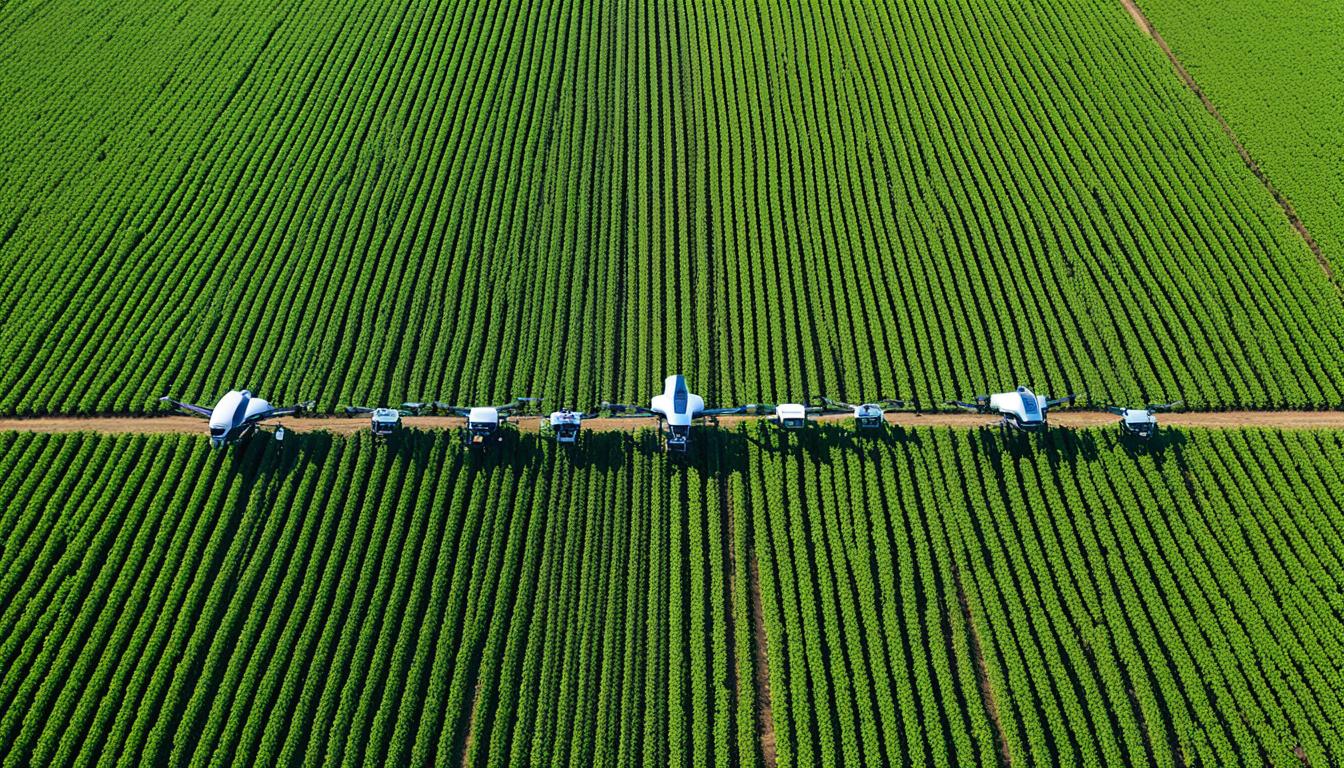
Did you know about 80 percent of today’s new farm tools come with precision farming tech? This number shows how quickly we’re adopting precision agriculture drones for smart farming.
Known as ‘Unmanned Aerial Vehicles (UAVs)’, these drones carry advanced cameras and sensors. They can spot soil conditions, check crop health, and monitor the weather. This high-tech helps farmers handle issues like plant diseases and bad weather. It also makes agriculture more productive, cuts costs, and meets the world’s growing food needs.
In Germany, high-tech farms have upped their harvests per hectare. They’ve also reduced herbicides and diesel by 10 and 20 percent. Over 4,500 machine makers are pushing for common tech standards to help farmers.
Drones in farming lower costs, lessen the impact of weather, and make farming smarter. As tech gets better, we expect more benefits from using drones in agriculture. This points to a future where farm decisions are based on smart data, boosting both production and sustainability.
Precision agriculture, known as precision farming, uses advanced techniques for better crop yield and wise use of farm resources. It uses current data and area analysis to focus on specific parts of fields. This makes crop management much more efficient.
At its heart, precision agriculture is about spotting, measuring, and dealing with the differences in crops by using technology. Drones play a key role by giving a top-down look at fields. This helps control crop health and manage resources in a smart way.
These drones have top cameras and sensors. They take detailed images and data from large areas. This helps in making well-informed decisions in farming. Moreover, special imaging tech, like hyperspectral and thermal cameras, helps spot crop issues early on. This allows for direct actions to solve them.
The upsides of precision agriculture are many. A big one is how drones apply pesticides, herbicides, and fertilizers accurately. This cuts down waste and ensures crops get the right treatment. It’s good for the planet, reduces waste, and helps nature thrive.
Drones also help make sure there’s enough food. They do this by looking after crops better, cutting waste, and boosting yields. The field of precision agriculture keeps on growing. More tools and smarter software are on the way. These will make farming even more precise and efficient.
The evolution of drones in farming has brought big changes. They began small but now play a key role in agricultural drone technology, improving how we farm.
At first, drones were used mainly for basic monitoring by flying over fields. This let farmers see issues like crop growth and where water wasn’t reaching. Even though they could only do simple tasks, these early drones started something big for UAV enhancements.
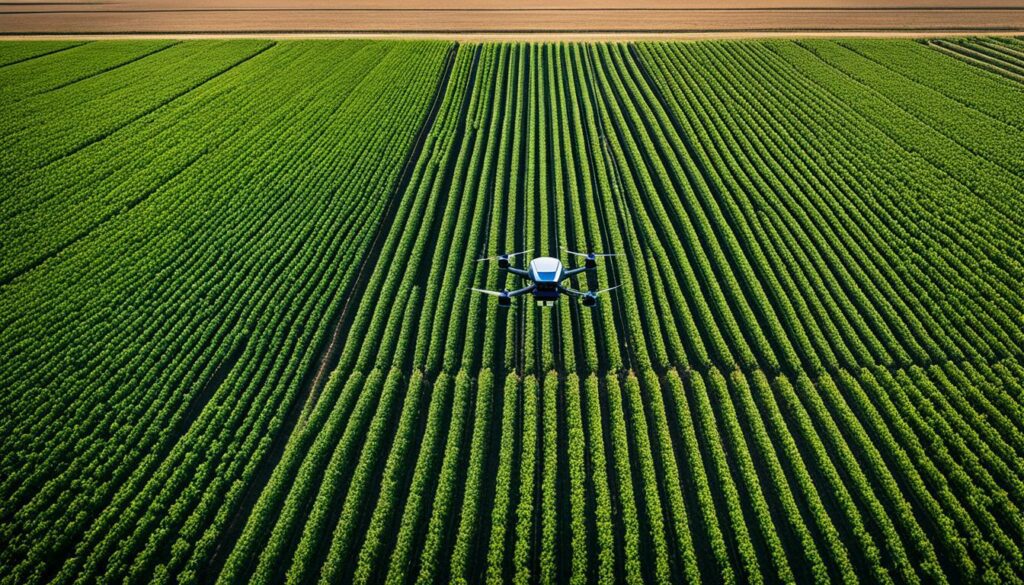
As time went on, drones got better and more helpful. Today’s drones have powerful sensors, high-quality cameras, and smart imaging tools. They can quickly check large areas, helping to spot plant diseases and check the soil. They also use artificial intelligence (AI) and learn by themselves (machine learning), offering accurate spraying and live health tracking without human control.
Today, high-quality imagery and distant sensing are key in precision farming. Drones are essential, giving farmers important data for observing, diagnosing, deciding, and acting with precision. This tech growth matches the trend towards farming that’s more effective and looks after the environment.
| Feature | Early Drones | Modern Drones |
|---|---|---|
| Applications | Basic aerial monitoring, mapping | Precision spraying, real-time health monitoring, multispectral imaging |
| Technology | Standard cameras | Advanced sensors, AI, machine learning |
| Coverage Efficiency | Limited areas | Large farms in hours |
Modern agriculture is more efficient with various UAV types. These include fixed-wing, rotary, and hybrid VTOL drones. Each type meets different farming needs well.
Fixed-wing drones are great for covering large farm areas. They fly for long periods, up to two hours or more. This allows for detailed tasks like field mapping and monitoring crops from above.
They are especially good when the weather is not great. With their ability to carry high-quality cameras, they are key in precision farming.
Rotary drones, or multirotors, are easy to move and operate. They can stay in one spot, which is perfect for watching over crops closely. They are great for analysing crops, checking soil, and managing irrigation.
Quadcopters, a kind of rotary drone, fly for shorter periods. But they can take very detailed photos. This makes up for their shorter flying times.
Hybrid VTOL drones have the benefits of both fixed-wing and rotary drones. They can take off vertically and cover large areas efficiently. This makes them useful for tasks like spraying pesticides and monitoring fields closely.
Although they are more complex and costly, they are very efficient. They can cover as much area in one flight as 14 flights of a multi-rotor drone.
Below is a comparison table highlighting the key features of these UAV types:
| UAV Types | Flight Time | Coverage Area | Operation | Best Use |
|---|---|---|---|---|
| Fixed-Wing Drones | Up to 2 hours or more | Large-scale areas | Efficient for long flights | Field mapping, crop monitoring |
| Rotary Drones | 20-30 minutes | Smaller, precise areas | High manoeuvrability | Detailed crop analysis, soil examination |
| Hybrid VTOL Drones | Up to 480 minutes | Large areas with precise coverage | Vertical take-off and landing | Pesticide spraying, detailed field monitoring |
The agriculture drone market is booming, set to hit $18.22 billion by 2030. This growth is driven by the key roles played by *drone sensors* and advanced *precision agriculture equipment*. They are essential for the industry’s development.
Multispectral cameras are crucial for spotting plant issues early. They work by capturing light in various bands, showing detailed images of plant health. For instance, the Parrot Sequoia+ uses this technology to check on crops.
Thermal imaging is vital for finding pests or stressed plants. By flying drones with thermal cameras over fields, farmers can act fast. This quick response can increase crop yields by up to 25%.
“By deploying drones, farmers can cover up to 500 acres in a single day, significantly enhancing efficiency and productivity.”
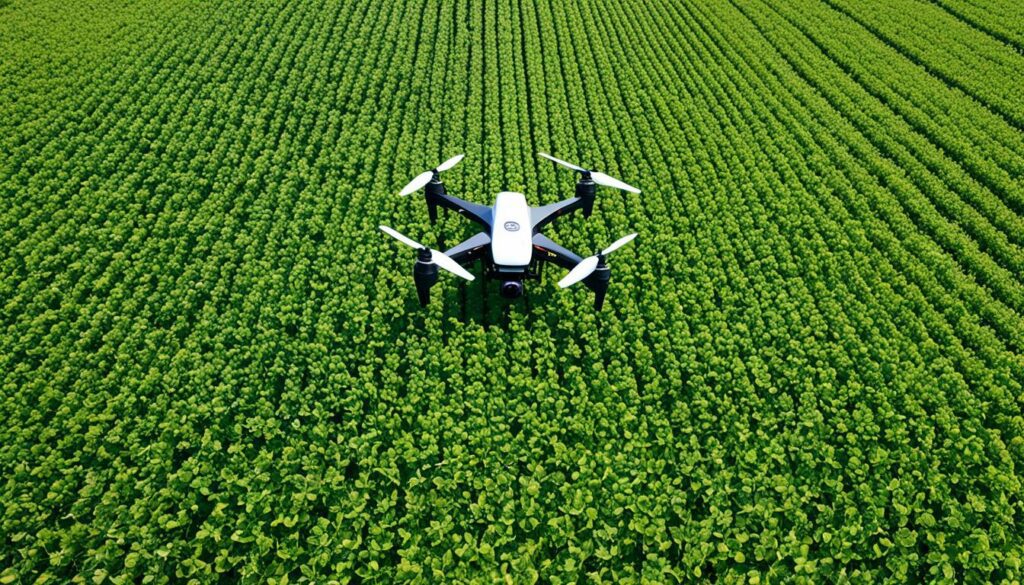
LiDAR technology provides 3D maps of farm land. This makes planning and managing resources easier. The JOUAV CW-25E drone, for example, is great for big farms, offering detailed maps quickly.
*Precision agriculture equipment* includes RGB cameras. With these, farmers can closely watch their crops and catch issues early. The Nano-Hyperspec, for instance, can spot issues in crop growth across 270 different light spectrums.
These drones can help cut down on chemical use by targeting where treatment is actually needed. They lessen the use of fertilisers and pesticides, cutting costs and helping the environment. By focusing treatments, they can also reduce chemical use by 35%, which keeps our planet healthy.
| Sensor Type | Function | Example | Cost |
|---|---|---|---|
| Multispectral | Detects plant health | Parrot Sequoia+ | ~$3,500 |
| Thermal | Reveals heat signatures | DJI XT2 | ~$6,000 |
| LiDAR | 3D Mapping | RIEGL miniVUX-1 | ~$15,000 |
| RGB | High-resolution imagery | Sony Alpha 7R IV | ~$3,000 |
| Hyperspectral | Captures data across multiple bands | Nano-Hyperspec | ~$35,000 |
By combining these sensors and cameras, agricultural drones are transforming farming. They convert data into insights, marking the start of a new, innovative chapter in agriculture’s history.
Precision agriculture drones are changing the face of farming. They offer precise crop monitoring and smarter use of resources. By doing this, they increase farm productivity. They also help farming be more efficient and caring for the environment and economy at the same time.
Drones are excellent at closely watching crops, which makes farms work better. They use special sensors to see things not visible to the human eye. This lets farmers quickly find pests, diseases, and crop water needs. By spotting these issues early, farms can produce up to 20% more food.
Drones make using farm resources better than before. They accurately apply things like water, fertilisers, and pesticides. This cuts down on waste and harm to the environment. Some farmers use 70% less pesticide and 97% less water because of these drones. This is not just efficient. It’s also good for the planet, helping reduce pollution and protect nature.
And, using drones saves a lot of money. Traditional farming can be very costly. For example, it takes a lot of fuel to sow seeds the old way. But with drones, this is done much faster. They can plant seeds over a large area in a short time. This means huge savings and makes farming a whole lot more efficient. By using drones, farms can watch their crops better and use resources more precisely. This results in better farm output overall.
AI and machine learning are changing how drones help in farming. They let drones do complex tasks alone, making farming more efficient. This method, known as data-driven farming, is making a big difference.
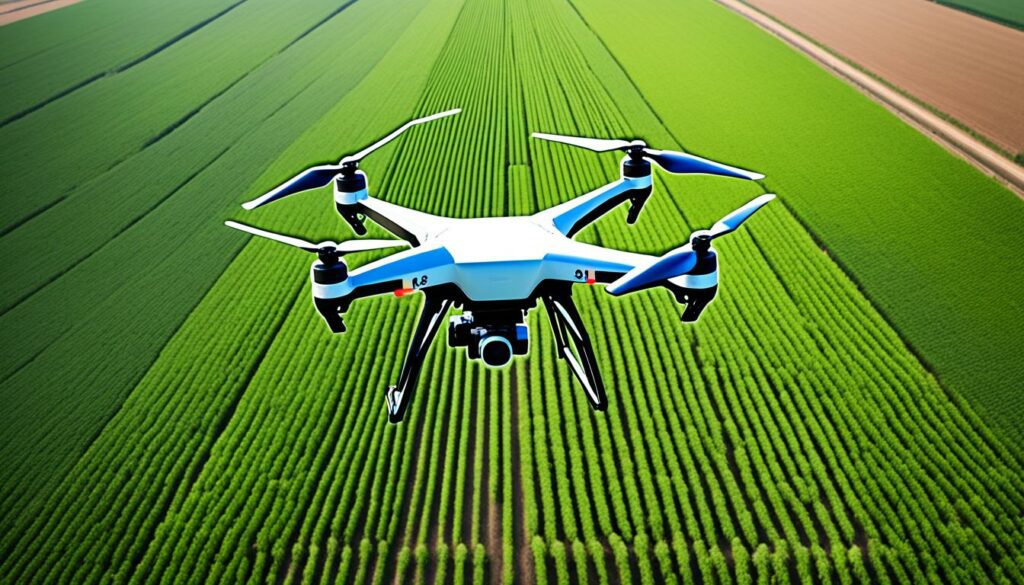
Daniel Candro in Colombia is a great example. He used AI with drones on his farm for better crop management. This boosted his earnings by 20% and saved water and chemicals. It shows how smart agriculture benefits from AI.
AI uses different techniques to guess crop yields and check how well crops are doing. It can also spot plant illnesses. As farm drones get smarter, they’re able to give farmers more helpful tips based on what they see right then.
Adding AI to precision farming is big news. For example, a tool called Blue River Technology’s Smart Sprayer is using cameras to aim herbicides better. It’s cutting herbicide use a lot, over 90%, which is great for the planet and the wallet.
Using AI alongside drones in farming is a big change. It helps farms do better, be more efficient, and make more money in a way that’s good for the earth. As technology keeps getting better, so will the way we farm with data.
High-resolution imaging and mapping are key for making farms work better. Modern agricultural drones offer these important features. They give farmers a clear look at their land. This helps them make great decisions and grow better crops.
Multispectral and RGB cameras are important. They let farmers see how healthy their crops are and how they’re growing. Multispectral helps find plant problems early, informing quick action. Meanwhile, RGB imaging creates detailed pictures. These images make it easier to watch over crops, spotting even the smallest changes.
LiDAR is changing farm mapping. It makes very accurate 3D models of the land. With this tech, farmers can map out the land’s elevation precisely. This detail is crucial for smart water use, soil checks, and planting plans. The accurate maps LiDAR creates help farmers make the best choices. This leads to using resources well and growing more crops.
Combining multispectral, RGB, and LiDAR data gives a full view of the farm. This view covers everything from the ground to the top of the crops. It helps farmers manage their land in a balanced way, improving how they work and taking care of the environment.
Using these advanced technologies is more and more important. The market for this tech is growing fast and will be very big by 2030. Precise farming methods can help cut down on harmful chemicals. They can lessen fertilisers, pesticides, and other chemicals by a lot. This is good news for the planet and our wallets.
In precision agriculture, drones are changing the game for soil and field assessment. They can make 3D maps of the soil that show detailed features. This is much better than old, simpler soil maps. It lets farmers get better and more useful data for farming.
Drones carry special cameras that measure the light that the soil reflects. This data helps create very detailed maps of the soil. The U.S. Department of Agriculture says these maps give us better soil information. Drones are key in looking at how land is changing and what plants need to grow well.
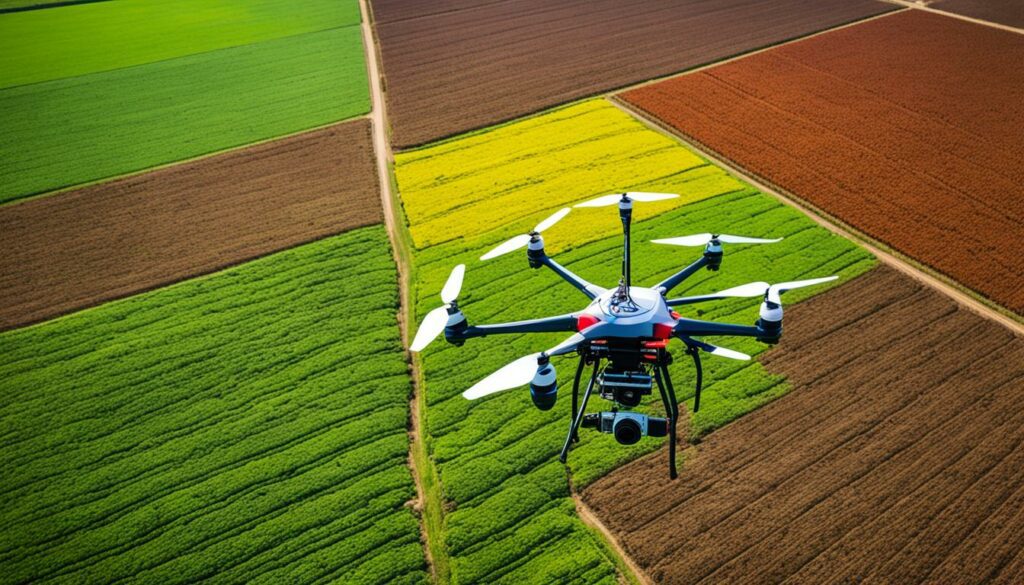
Using drones, farmers can check on how wet the soil is and where water moves. This info is vital for managing water well, stopping soil from washing away, and keeping plants well-fed. Early on, drones can also show how healthy the soil is. This helps farmers know where and how to plant crops.
This high-tech farming doesn’t stop after planting. It keeps an eye on the soil and plants all season. This allows for quick fixes, like adjusting watering or adding nutrients. It makes sure crops stay healthy and farms produce more.
Moreover, maps showing soil quality from drone data help pick the best spots for planting. Using drone soil analysis helps farmers grow more food in a way that keeps the land healthy. This is a big win for farming.
Real-time data collection and processing are key to modern precision agriculture. They let farmers respond quickly to issues. This is vital for using smart farming strategies to make work more efficient and productive.
With real-time data collection, farmers can act fast to reduce risks and boost crop health. 86% of farmers find quick data collection with mobile devices important. Mobile data can increase field coverage by 40%, making decision-making more accurate.
| Metric | Improvement |
|---|---|
| Field Coverage Increase | 40% |
| Mapping Capabilities | 55% Improvement |
| Training Time Reduction | 60% |
| Data Collection Costs | 50% Reduction |
| Trends and Patterns Identification | 45% Increase |
Fast processing of agricultural data helps farmers adjust their field practices promptly. Working together in precision agriculture has improved decision support by 30%. Automation in data collection has cut down collection and analysis time by 25%, raising productivity.
Mobile data technology has been spreading in farms of all sizes. This has increased its use by 35% among small farms. These tools help create more accurate and efficient field strategies, using resources better and increasing crop yields.
The use of drones is changing agriculture a lot. They show us how many different ways they can help on the farm.
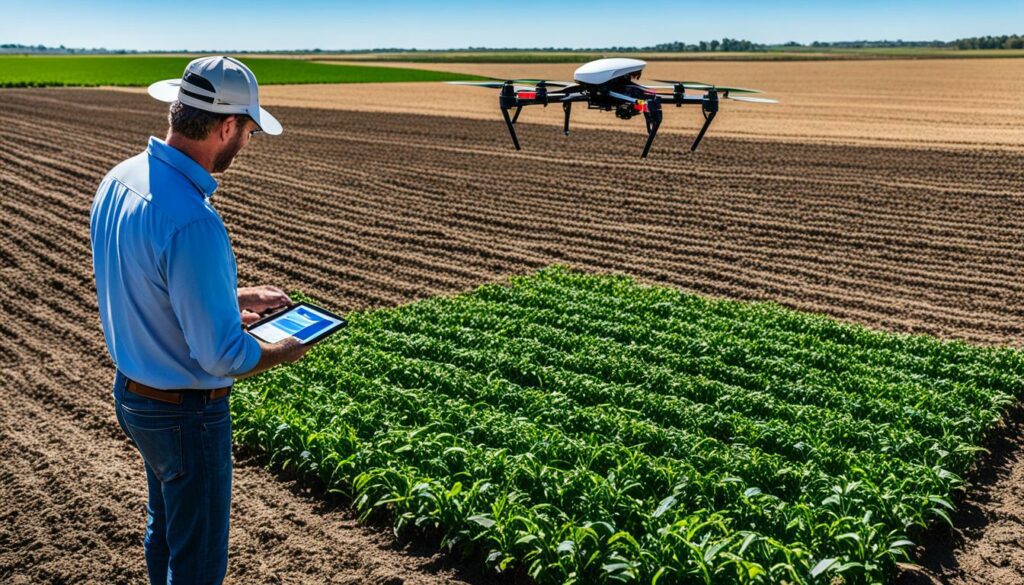
Drones, using multispectral imaging, have boosted wheat farm yields a lot. They help take better care of vineyards and save water in dry avocado fields. In Brazil, drone images cut herbicide use on soybean farms by 52% by targeting weeds.
JOUAV drones are really special. They can take off and land vertically and fly for almost 8 hours. This ability to fly for a long time helps farmers save a lot of resources.
Drones don’t just save time, they also cut costs and help the planet. They reduce the need for fertilisers and pesticides by a lot. This means fewer chemicals in our air and water. The result is more food and money for farmers.
Thanks to drones, diseases in crops are spotted early, creating a 25% boost in yields. This smart farming with drones is proving its worth. With more success stories, drones are becoming key in making farming better.
In the past few years, there have been big steps forward in drone battery tech. This has really changed farming. Now, drones can fly for longer, covering more ground. This makes monitoring big farms much easier and more detailed.
Better drone batteries mean they can fly much longer. This is great news for big farms. They can now cover more area with each flight, saving time and work. With top-quality sensors and these new batteries, farmers can get detailed info on crops and soil with no breaks.
Drone batteries are also boosting how far they can fly. This is perfect for checking farms that stretch for miles. Now, with fewer breaks, they can cover all spots. This means more efficient farming and helping crops grow better and greener.
The growth in drone battery tech is a game changer for farming. It makes managing farms a lot easier and better. It lets farmers get all the info they need in one go.
To wrap it up, better batteries for drones mean they can work longer and see more. This really helps with the smart farming everyone is talking about.
Drone spraying is changing how we farm by spraying pesticides and fertilisers with extreme accuracy. These drones can work on any land, making sure chemicals are used evenly. This makes farming more efficient, helps the environment, and boosts crop health and yields.
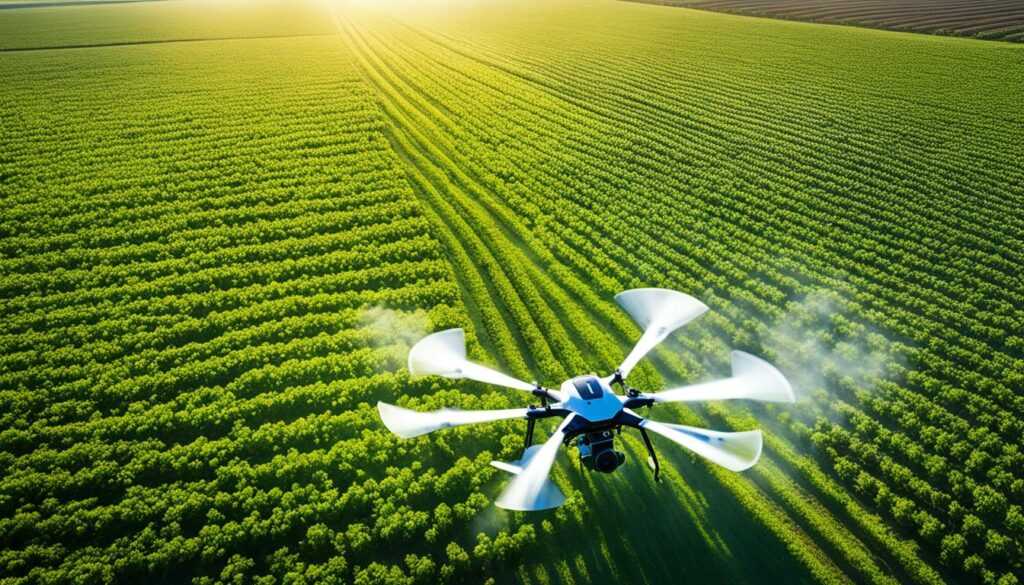
Compared to the old ways, drones can target areas precisely, saving on chemicals. They’ve cut down the need for herbicides by 52% in some places. This is thanks to drones spotting weed problems using high-tech imaging. This also means more crops are grown for less money spent.
The use of agricultural drones is rapidly growing. In 2019, the market was worth $1.2 billion but by 2024, it’s expected to jump to $4.8 billion. South Korea is leading the way with drones doing 30% of the spraying. But, rules on drone use vary a lot from place to place. They’re working on these rules in countries like Canada to keep farming safe.
“Farmers using drones have found their crops are better, costs are lower, and they produce more. This is a big step for farming, showing the real benefits of drones in managing crops.”
The trend of using drones in farming is only going to get stronger. With more tech advancements, these drones offer smarter ways to protect our crops. This means better and more sustainable farming for everyone.
It’s important for farmers to follow FAA drone regulations when using UAVs. They must get FAA certification for any commercial drone work. This includes drones for precision farming. Farmers need to know the airspace rules, deal with risks, and understand their drone’s limits.
To comply with laws, drones should fly below 400 feet (120 meters). They must be registered. Following these rules helps keep farming safe and efficient. It also covers privacy, ensuring farm work doesn’t violate others’ privacy.
Knowing how to get licenses is key. Farmers need several, such as an FAA Part 107 for piloting drones. They may need an FAA Part 137 for spraying, and a state license for commercial aerial work. State rules are different and might include tests and training. For drones over 55 pounds, extra permissions are needed and can be requested online.
The main goal is to make agriculture safer and more efficient with drones. Following the rules combines UAV farming compliance with better farm practices. This leads the farming sector towards advanced, technology-focused solutions.
The market for agricultural drones is booming. This growth is powered by the need for better farming solutions and high-tech tools. Analysts expect the market to grow even more in the next few years.
By 2029, the worldwide market for agricultural drones could hit USD 4.36 billion. This is up from an estimated USD 2.08 billion in 2024. The use of drones in farming is quickly advancing.
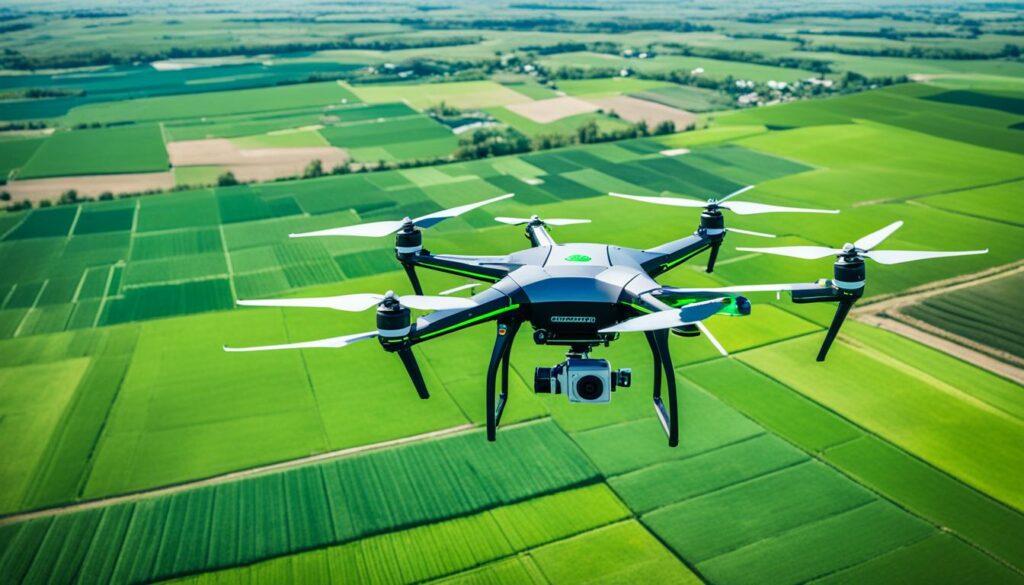
The appetite for drones in farming is rising. One reason is the shrinking amount of available land for agriculture. Also, new digital tools are making farm work more efficient. These changes will make farming smarter and more precise.
Companies like DJI Agriculture and AgEagle are changing the game with their new tech. They focus on improving soil, keeping an eye on crop health, and using smart spraying methods. This tech helps farmers do their work better.
The number of patents for agricultural drones has been growing. Between 2012 and 2022, many new ideas got the green light. This shows the industry is always working on better solutions for farming.
| Year | Market Value (USD Billion) | CAGR (%) | Major Players |
|---|---|---|---|
| 2023 | 1.78 | 15.7 | DJI Agriculture, AgEagle |
| 2024 | 2.08 | 16.05 | AeroVironment Inc., Parrot SA |
| 2025 | 2.41 | 16.1 | PrecisionHawk, DroneDeploy |
| 2028 | 3.73 | 16.0 | Trimble Inc., Sentera |
| 2029 | 4.36 | 16.05 | SenseFly, UAVOS Inc. |
The future looks bright and exciting for drones in agriculture. New tech products are on their way. They promise to make farming even more modern and efficient. The industry is ready for big changes and lots of new growth.
To stay up to date with this fast-moving sector, check out detailed market reports for the most recent insights.
Drones offer many advantages to farming but face several challenges. These include technical issues, regulatory hurdles, and high costs. Overcoming these problems is key to using drone tech more widely in agriculture.
UAV technical limitations like hardware issues and software problems are key hurdles. Drones can suffer from battery concerns and need constant equipment checks. To ensure drones run smoothly and safely, upkeep, updates, and following protocols are vital.
Regulatory hurdles are significant precision farming obstacles facing farmers. They have to meet legal needs for safety, privacy, and environmental impact. This might mean getting permits or following specific rules. Knowing and sticking to these laws is essential for using drones legally in agriculture.
UAV operational constraints also make managing drone data a challenge. The information drones gather is often massive and hard to interpret. Handling images, videos, and maps properly is crucial for gaining useful insights.
| Type of Issue | Details | Impact |
|---|---|---|
| Regulatory Issues | Compliance with safety, privacy, security, and environmental laws. Registration, licensing, and certification required based on location. | High – Diverse implications for legal use |
| Technical Issues | Hardware malfunctions, software glitches, communication failures, and battery depletion. | High – Affects safety and efficiency |
| Cost Issues | High initial investment and ongoing maintenance costs. | Medium – Financial constraints for small farms |
| Data Issues | Complexity, size, and noisy nature of drone-collected data requiring specialised skills. | Medium – Requires infrastructure and skilled personnel |
| Social Issues | Ethical dilemmas, privacy concerns, stakeholder perception, and public acceptance. | Medium – Influences trust and cooperation |
In farming today, using precision agriculture drones is a big step forward. They help in making farming more efficient and sustainable. Even though not many farmers use them yet, their benefits are clear. These drones can quickly cover large parts of farms, giving detailed views for better monitoring.
Precision agriculture combines many tools and methods. Farmers use detailed images from space or drones for close observation and decision-making. Tools like Auto-Guidance Equipment and GIS Software are crucial. Companies like GeoSys and PlanetWatchers are leading in this field, aiming to make farming smarter.
Drones are used for many tasks in farming, such as watching over crops, checking the soil, and helping with irrigation. They allow farmers to make smarter choices, improving how they manage crops. As drone tech gets better, their role in upgrading farming practices will grow. This change ushers in a new farming age, focused on better productivity and eco-friendliness.
Precision agriculture is a modern farming approach. It uses technology to boost crop yield and cut down on waste. It does this by looking at real-time data and fields closely. This helps make farming more efficient while being gentler on the environment.
This method improves many things on the farm. It raises how much crops produce. It also makes better use of resources. This way, farming does less harm to the planet. And, it helps farmers make smarter choices thanks to new tech.
Drones used in farming have come a long way. They started with basic mapping and now carry high-tech sensors. These include cameras that see plant health and LiDAR for mapping. Drones can do deep checks on soil and plants. And they can do this all on their own thanks to AI.
In farming, there are several drone types in action:- Fixed-Wing Drones: Good for mapping fields as they can fly long and far.- Rotary Drones: These fly like helicopters and are great for close-up crop checks.- Hybrid VTOL Drones: They mix the benefits of both, useful for tasks like spraying crops.
Many sensors are found in farming drones. There are cameras for checking plant health. Some look for heat changes and others map in 3D. Together, these sensors give detailed info for farming decisions.
These drones help by closely watching crops and managing resources better. They make it easier for farmers to do tasks like watering and spraying. This saves time and money. And it makes farms work better overall.
AI and machine learning are big helpers in drone farming. They let drones work on their own and analyse data fast. This means they can do things like spray crops or water fields by themselves. It makes farming smarter and greener.
Drones use special cameras to get detailed pictures of crops. They also use LiDAR for making 3D maps. All this data is key for making farms run well throughout the year.
Using drones for checking soil and fields gives very accurate maps. Farmers can use these to do things like plant seeds in the best spots. This kind of check-up means better farm management overall.
Getting data quickly is vital for making farming work right. It lets farmers react fast to issues that come up. This leads to better farming that uses resources well.
Drones are already helping out in farming around the world. They’ve made big differences in things like grape growing. They’ve also cut down on water use in making avocados. And they’re increasing the quality of crops with their special sensors.
Better batteries mean drones can fly for longer. This is great for big farms that need a lot of watching over. A longer flight time means more work done in one go, which is a big plus.
Drone spraying is a new way to put down things like pesticides or fertilisers. Drones fly low over the fields to do it right. This method is spot-on, uses less chemicals, and gets the job done fast.
Farmers in the U.S. have to follow rules when using drones. This includes getting a special licence, knowing the airspace rules, and registering each drone. These rules are there to make sure drones are used safely and carefully.
The market for farming drones is set to get much bigger. By 2029, it could be worth over USD 4 billion. North America and Europe will be big in this growth, with leading companies offering all sorts of UAV solutions for farming needs.
Using drones in farming does have its challenges. There are issues to do with learning how to use them and laws to follow. Plus, the cost to get started can be high for some farms. Still, with time and effort, these hurdles can be overcome.